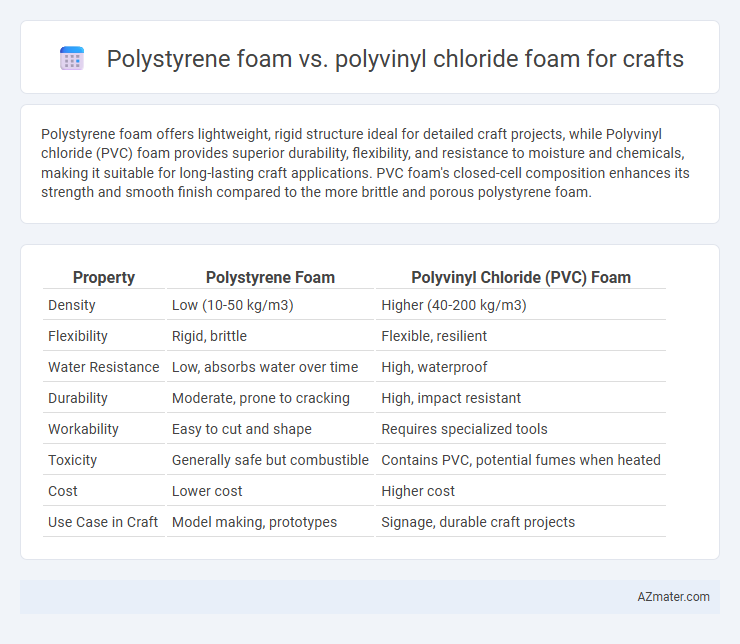Polystyrene foam offers lightweight, rigid structure ideal for detailed craft projects, while Polyvinyl chloride (PVC) foam provides superior durability, flexibility, and resistance to moisture and chemicals, making it suitable for long-lasting craft applications. PVC foam's closed-cell composition enhances its strength and smooth finish compared to the more brittle and porous polystyrene foam.
Table of Comparison
| Property | Polystyrene Foam | Polyvinyl Chloride (PVC) Foam |
|---|---|---|
| Density | Low (10-50 kg/m3) | Higher (40-200 kg/m3) |
| Flexibility | Rigid, brittle | Flexible, resilient |
| Water Resistance | Low, absorbs water over time | High, waterproof |
| Durability | Moderate, prone to cracking | High, impact resistant |
| Workability | Easy to cut and shape | Requires specialized tools |
| Toxicity | Generally safe but combustible | Contains PVC, potential fumes when heated |
| Cost | Lower cost | Higher cost |
| Use Case in Craft | Model making, prototypes | Signage, durable craft projects |
Introduction to Craft Foams: Polystyrene vs Polyvinyl Chloride
Polystyrene foam offers lightweight, rigid properties ideal for model making and decorative crafts, featuring ease of cutting and shaping with tools. Polyvinyl chloride (PVC) foam provides higher durability, chemical resistance, and flexibility, suited for more resilient craft projects requiring detailed finishes. Both foams vary in density, texture, and workability, influencing their selection based on project demands and environmental exposure.
Material Composition and Properties
Polystyrene foam, composed of polymerized styrene monomers, offers lightweight, rigid properties with excellent insulation and ease of cutting, making it ideal for detailed craft projects. Polyvinyl chloride (PVC) foam consists of polymerized vinyl chloride, characterized by its denser, more durable, and flexible structure, providing superior impact resistance and chemical stability for long-lasting crafts. The choice between these materials depends on the desired balance between rigidity, durability, and ease of manipulation in craft applications.
Weight and Density Comparison
Polystyrene foam typically exhibits a lower density, ranging from 10 to 30 kg/m3, making it significantly lighter than polyvinyl chloride (PVC) foam, which ranges between 40 to 200 kg/m3. The lightweight nature of polystyrene foam allows for easier handling and cutting in craft applications, whereas PVC foam's higher density offers greater durability and rigidity. Weight differences impact project portability and structural requirements, with polystyrene favored for lightweight models and PVC chosen for crafts needing sturdier, more resilient materials.
Ease of Cutting and Shaping
Polystyrene foam offers superior ease of cutting and shaping for craft projects due to its lightweight structure and uniform density, allowing precise cuts with simple tools like craft knives or hot wire cutters. Polyvinyl chloride (PVC) foam, while denser and more rigid, requires sharper tools or power equipment for clean cuts but provides greater durability for long-lasting craft items. Both materials respond well to sanding and sculpting, though polystyrene foam is preferred for intricate designs because of its softer, more malleable nature.
Surface Finish and Paintability
Polystyrene foam offers a smooth surface finish that readily accepts various paint types, making it ideal for detailed craft projects requiring fine texture and vibrant color application. Polyvinyl chloride (PVC) foam features a slightly denser surface with increased durability but may require surface preparation, such as sanding or priming, to enhance paint adhesion and achieve an even finish. Both materials provide versatility in crafting, but polystyrene foam is often preferred for superior paintability and crisp surface detail.
Durability and Structural Strength
Polystyrene foam offers lightweight properties with moderate durability, making it suitable for temporary craft projects but prone to brittleness and cracking under stress. Polyvinyl chloride (PVC) foam provides superior structural strength and long-lasting durability, resisting impact, moisture, and chemical exposure, ideal for detailed craft work that requires robustness. Choosing PVC foam ensures enhanced longevity and stability in crafted items compared to the more fragile Polystyrene alternative.
Safety and Toxicity Considerations
Polystyrene foam, commonly used in crafts, is lightweight but releases toxic styrene fumes when cut or heated, posing respiratory hazards and requiring good ventilation. Polyvinyl chloride (PVC) foam contains plasticizers and additives that can emit harmful chemicals like dioxins during cutting or burning, raising concerns about long-term exposure and skin contact. Selecting low-toxicity, certified-safe foam materials and using protective equipment reduce health risks associated with both polystyrene and PVC foams in craft applications.
Cost Analysis for Crafters
Polystyrene foam offers crafters a lower-cost option compared to Polyvinyl chloride (PVC) foam, making it ideal for budget-conscious projects. While Polystyrene foam is more affordable per square foot, it is less durable and less flexible than PVC foam, which may influence long-term cost-effectiveness depending on project requirements. PVC foam commands a higher price but provides superior durability and ease of shaping, potentially reducing replacement and material waste costs in complex craft applications.
Environmental Impact and Recyclability
Polystyrene foam, commonly used in crafts, poses significant environmental challenges due to its non-biodegradable nature and difficulties in recycling, often ending up in landfills or as ocean debris. Polyvinyl chloride (PVC) foam, while offering durability and chemical resistance in craft applications, has a higher environmental footprint due to toxic chemicals released during production and limited recyclability options. Choosing materials with better end-of-life management, such as recyclable PVC or alternative eco-friendly foams, is crucial for reducing environmental impact in crafting projects.
Best Applications for Each Foam Type
Polystyrene foam excels in lightweight craft applications such as model making, insulation, and decorative displays due to its rigidity and ease of cutting. Polyvinyl chloride (PVC) foam is better suited for projects requiring durability, water resistance, and structural strength, like signage, cosplay props, and custom furniture. Choosing between polystyrene and PVC foam depends on the specific craft requirements for flexibility, sturdiness, and environmental exposure.

Infographic: Polystyrene foam vs Polyvinyl chloride foam for Craft
 azmater.com
azmater.com